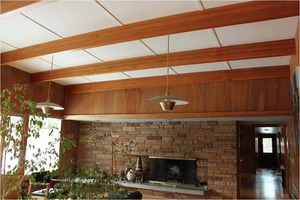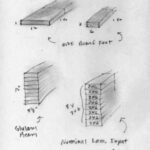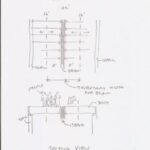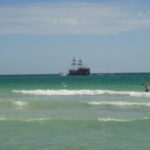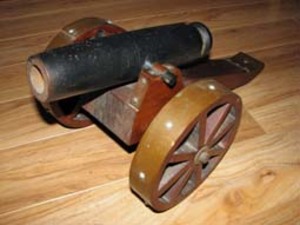1. Glulam – What is it?
Glulam is short for GLUED LAMINATED TIMBER.
`TIMBER is defined as `wood for building’. Specifically, timbers are `sizeable framing elements for buildings or other structures.’ LAMINATED betrays that the timbers are made up of individual laminations, traditionally rather flat, or thin, such that the end product may be much larger than individual parts. GLUED betrays that the laminations are bonded to one another with glues, or adhesives.
Glued Laminated Timbers are relatively large structural wood elements made from relatively small wood pieces bonded together.
Individual laminations are of sizes conveniently available to manufacturers.
Resulting timbers are of sizes desired by structural engineers, architects, and builders.
Strategic use input of wood results in laminated timbers often being stronger and stiffer than sawn (pure wood) timbers of similar wood species and dimensions.
Laminated timbers are often of greater cross section than sawn timbers, sometimes much, much greater.
The ability of manufacturers to join input pieces end-to-end allows the resulting timbers to be longer, often much longer, than their sawn counterparts.
In fact, in general, glued laminated timber lengths are generally dictated by storage and transportation issues, not the input resource.
The ability to utilize strong wood where it is needed, and lesser strength wood where lesser strength is needed, allows for efficient and effective (`optimized’) use of our wood resources.
Glued laminated timbers are manufactured in accordance with accepted standards resulting in high quality structural members.
2. What Glulam is NOT.
Glulam, at least in the context of this conversation, refers ONLY to timber members manufactured in accordance with the accepted American manufacturing standards ANSI/AITC A190.1 American National Standard – for wood products – Structural Glued Laminated Timber, American Institute of Timber Construction (Sponsor) …
… and …
… designed in accordance with the Design Values and Adjustment factors of Standard Specification for Structural Glued Lamented Timber of Softwood Species, AITC 117, American Institute of Timber Construction.
ANSI/AITC 190.1 is the cited standard for quality in the International Building Code.
The Design Values and adjustment factors of AITC 117 are the bases of the Design Values and Adjustment factors for Glulam in the National Design Specification for Wood Construction (NDS); the NDS is the standard for design of wood construction.
Laminated timbers manufactured according to other standards (good or bad, domestic or foreign), or to no standards at all, are not part of this conversation. Nail-laminated or bolt-laminated timbers are not part of this conversation. For the purposes of this Seminar, these other timbers … ARE NOT GLULAM.
The manufacturing and design of Glued Laminated Timbers in accordance with the above standards is a highly evolved Industry.
Manufacturers, Designers and Builders of Glulam today benefit from immense amounts of science, research, testing, and in-service experience … gone before us.
Glued Laminated Timbers are manufactured using adhesives that are durable and `taken to be’ stronger than the wood being bonded; wood strength controls design.
3. Standard Sizes
Glued laminated timbers are generally manufactured from `lamination stock’ sawn lumber of sizes and grades similar to Dimension Lumber. Lamination stock material is generally `laid flat’ (wide faces bonded to one another). Finish Glulam widths are generally slightly smaller than the input wide face dimension, and multiples of the narrow dimension (thickness), for depth. Individual laminations may also be made up of multiple pieces, bonded (or not) on their edges..
Western Softwood Glued Laminated Timber
Typical Widths: 3-1/8 in., 5-1/8 in., 6-3/4 in., and 8-3/4 in., 10-3/4 in. … and wider!
Depths: multiples of 1-1/2 in. … as deep as you want to go.
Southern Pine
Typical Widths: 3-1/8 in., 5-1/8 in., 6-3/4 in. … (same)
Depths: multiples of 1-3/8 in. …. also as deep as you want to go.
Widths of 1-1/2 in., 2-1/2 in., 3-1/2 in., 5-1/2 in. … and others … are also available.
The 3-1/2 and 5-1/2 widths are popular in that they match Dimension lumber and Sawn Timber widths.
Glued Laminated Timbers may also be ordered or specified in I-Joist Compatible’ (IJC) depths matching common I-joist depths of 9-1/2 in., 11-7/8 in., etc.
Glued Laminated Timbers are generally `priced’ according to the `Board Foot Measure’ of the input material. Board Foot Measure is based on the nominal dimensions of the input laminations. The sizes of the resulting timbers are generally described by the `actual’ finish dimensions, though sometimes near equivalent `nominal’ sizes are used in their descriptions.
4. Glulam Layup Types
Glued Laminated Timbers Layups are generally of three types, two of which are generally used for beams, and the third for columns, as follows:
BEAMS
1) Optimized Unbalanced Layup – manufactured to resist extreme fiber tension stress on one face only. These members are intended for use as simple beams where flexural tension stresses are resisted on one face only (typically the `bottom’ of the beam where resisting gravity loads).
2) Optimized Balanced Layup – manufactured to resist extreme fiber tension on both faces (both `top and bottom’).
3) Uniform Layup – uniform grade laminations for the entire section – intended to resist uniform stresses such as for columns.
5. Glulam Shapes
Glued Laminated Timbers may be manufactured into a variety of shapes (geometries) including:
1) Tapered Beams
Beams with tapered end cuts
Single tapered beams
Double tapered beams
Tapered beams may be manufactured by `cutting’ the taper(s) into members manufactured in prismatic shapes, or may be manufactured using tapered laminations.
2) Curved Beams
Shallow cambered beams
Constant radius curved beams
Varying or reversed curvature beams
3) Pitched and Tapered Curved Beams
4) Arch Members
5) As Truss and Other Members
6. Visibility and Appearance
Glued Laminated Timbers have the aesthetic and architectural appeal of `structural wood’. They are often used in `visible’ applications revealing both structure and beauty. They are also used commonly in hidden framing. A wide variety of Appearance Grades are available for specification, from `Premium’ on the elegant end to `unfinished’ for timbers in industrial applications or where not visible. They may be manufactured with varying color wood laminations, or more uniform. They may be stained, painted, covered, or left as is from the manufacturing process. Timbers of uniform lamination color may also be `roughed’ up to appear as large solid sawn members. Occasionally other building materials are finished to look like `timbers. Seldom is it desired or necessary to make timbers appear something different than what they are … beautiful wood.
7. Engineering
The Glued Laminated Timber Industry has labored (and continues still) to make the engineering of Glulam as simple and direct as possible. As with all structural wood engineering – adjustments must be made from `standard’ conditions for which design information is provided – to the `service’ conditions of each structure or project. That’s where wood engineering is complicated. Otherwise, Glulam is relatively simple. A great many Glulam members end up as simple beams and columns, for which engineering design is relatively `easy’. Most Glulam applications are statically determinate. Though the `insides’ of a Glulam may be complicated (optimized layups), the Industry-provided Design Values allow designers to use section properties based on physical dimensions rather than the necessity of transformed section analysis (to accommodate different stiffness laminations). Design solutions may be accomplished by `hand calculation’, or as assisted by computer spreadsheets, commercially available design computer software, and software provided by manufacturers. A great deal of written technical information is also provided to assist the designer of Glulam. In some applications sophisticated finite element solutions of statically indeterminate applications are necessary. A great many Glulam beams have been `sized’ using Industry or Manufacturer supplied `Span Tables’.
8. Summary
Glued Laminated Timbers are used across a whole array of structural applications, to sizes as `small’ as joists, rafters, or decking pieces, to beams, posts, girders, columns, to larger much larger beam and arch sizes. Indeed Glued Laminated Timbers may be manufactured to sizes much larger than what are possible in solid wood. Glued laminated timbers may be used as simple framing members, hidden or not, or may be used as elegant, exposed main structural support member, defining the structure itself. And a whole host of other uses in between.
References
ANSI/AITC A190 – American National Standard – for wood products – Structural Glued Laminated Timber, 1 American Institute of Timber Construction (Sponsor), Centennial, CO.
Standard Specification for Structural Glued Laminated Timber, AITC 117, 2004 (and 2010), American Institute of Timber Construction, Centennial, CO.
National Design Specification for Wood Construction (NDS) and Supplement – Design Values for Wood Construction, 2005 (and 2012), American Forest and Paper Association, Washington, D.C.
International Building Code, International Code Council, Country Club Hills, IL.
Standard Appearance Grades for Structural Glued Laminated Timber, AITC 110, American Institute of Timber Construction, Centennial, CO.
